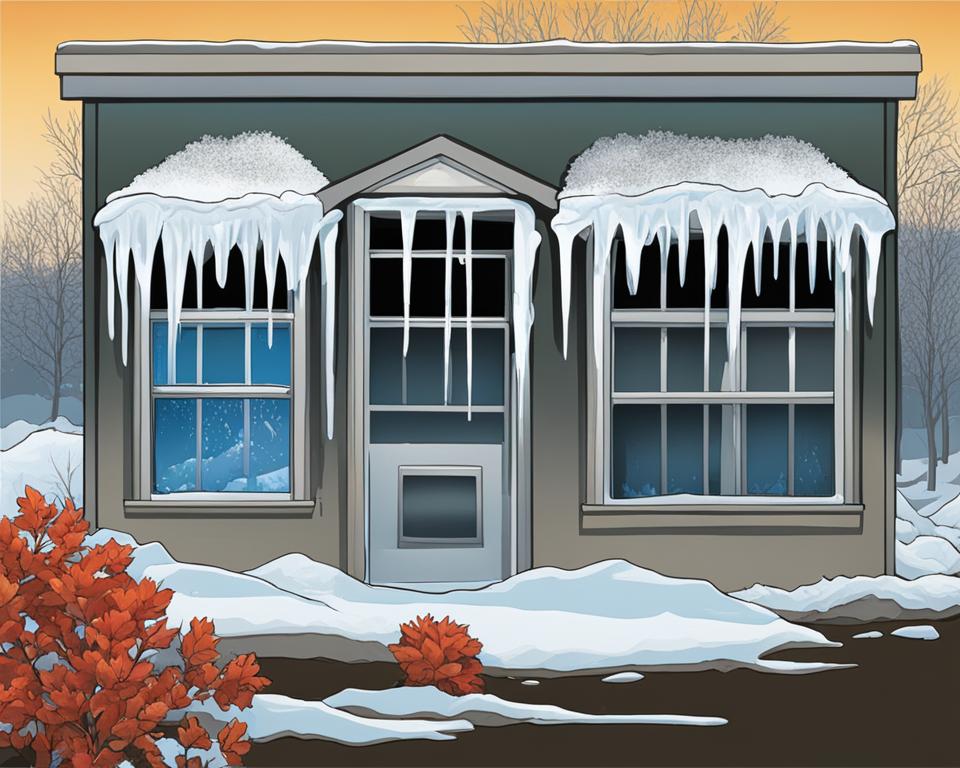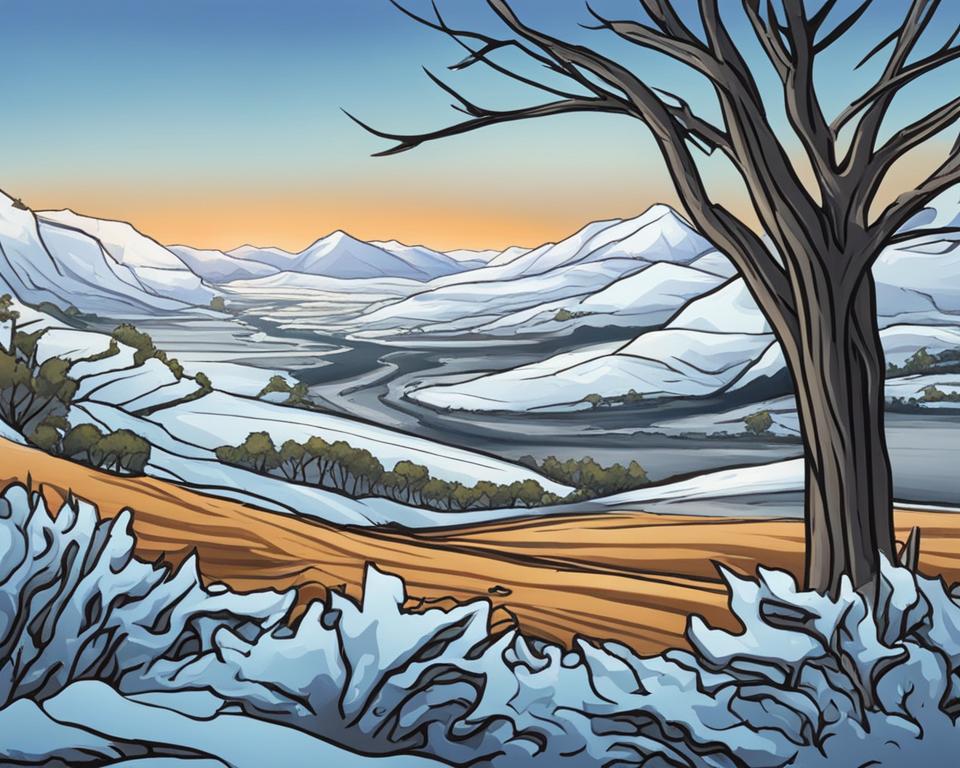A freeze warning is a weather advisory issued by the National Weather Service (NWS) to alert the public of significant, widespread freezing temperatures. It is essential to understand the definition and meaning of a freeze warning, as it helps in preparing and safeguarding oneself, property, and plants from potential frost damage. This comprehensive guide will provide you with all the necessary information about freeze warnings and how to respond to them.
Key Takeaways:
- A freeze warning is a weather advisory issued by the NWS to warn the public of significant freezing temperatures.
- Understanding freeze warnings is crucial for protecting yourself, your property, and your plants from potential frost damage.
- Freeze warnings are based on forecasted conditions and can be issued up to 36 hours in advance.
- When a freeze warning is issued, take proactive measures to cover plants, bring sensitive plants indoors, and follow recommended precautions.
- Knowing the differences between freeze warnings and frost advisories can help interpret weather advisories more effectively.
Understanding Frost and Freezing Temperatures
Frost can occur when the temperature falls below 36°F, particularly in rural areas. The NWS does not specifically track “frost” but instead monitors when temperatures hit the freezing mark or fall below. Frost becomes more widespread when the temperature falls below 32°F, and this is where a freeze can occur. It is important to note that a hard freeze is possible when temperatures dip below 28°F. Understanding these temperature thresholds is crucial in interpreting freeze warnings.
When the temperature drops below 36°F, frost can form on surfaces such as grass, roofs, and car windshields. This occurs due to the water vapor in the air condensing into ice crystals. The formation of frost can be visually appealing, creating a picturesque winter scenery. However, it can also pose risks to plants and crops, leading to frost damage.
| Temperature Range | Impact |
|---|---|
| 36°F to 32°F | Frost forms on surfaces |
| 32°F to 28°F | Potential for a freeze; frost becomes more widespread |
| Below 28°F | Potential for a hard freeze |
During a freeze warning, it is essential to take appropriate precautions to protect yourself, your property, and your plants. This can include covering plants, using protective measures such as frost blankets or mulch, and bringing sensitive plants indoors if possible. By understanding the temperature thresholds and the potential risks associated with freezing temperatures, you can better prepare and respond to freeze warnings to minimize damage and ensure the safety of your surroundings.
Freeze Warning Criteria and Conditions
A freeze warning is issued by the National Weather Service (NWS) based on specific criteria and conditions. Understanding these factors is crucial in interpreting freeze warnings and taking appropriate precautions. The following are the freeze warning criteria and conditions:
Criteria:
- Significant and widespread freezing temperatures
- Temperatures expected to reach 29-32°F
A freeze warning is typically issued when these criteria are met, indicating a higher risk of freezing temperatures. It is important to note that freeze warnings are based on forecasted conditions and can be issued up to 36 hours in advance, allowing individuals and communities to prepare.
Conditions:
- Imminent or already occurring freezing temperatures
- Potential for frost damage
When a freeze warning is in effect, it means that freezing temperatures are expected or already happening. This can have significant implications, especially for plants and crops. Frost damage can occur when plants are exposed to freezing temperatures, leading to brown spots, plant death, and other negative effects. It is important to take proactive measures to protect your plants and minimize damage.
| Freeze Warning Criteria | Conditions |
|---|---|
| Significant and widespread freezing temperatures | Imminent or already occurring freezing temperatures |
| Temperatures expected to reach 29-32°F | Potential for frost damage |
By understanding the freeze warning criteria and conditions, individuals can be better prepared and respond effectively to freezing temperatures. Taking necessary precautions, such as covering plants and bringing sensitive plants indoors, can help minimize the impact of frost and freezing temperatures. Stay informed about freeze warnings and follow the specific recommendations from the NWS to protect yourself and your property.
Implications of a Freeze Warning
A freeze warning indicates that freezing temperatures are imminent or already occurring. This can have significant implications, particularly for plants and crops. Frost damage can occur when plants are exposed to freezing temperatures, leading to brown spots, plant death, and other negative effects. It is crucial to take proactive measures to protect your plants and minimize damage when a freeze warning is issued.
During freezing temperatures, the water inside plant cells freezes, causing crystals to form. These ice crystals can rupture cell walls, leading to irreversible damage. Additionally, freezing temperatures can disrupt the flow of nutrients and water within the plant, further compromising its health. Plants most vulnerable to frost damage include sensitive annuals, tender perennials, and young or newly transplanted plants.
To protect your plants during a freeze warning, there are several precautionary steps you can take. Start by covering susceptible plants before sunset to retain heat. Use materials such as blankets, frost cloth, or plastic to create a protective barrier. Be sure to secure the coverings properly to prevent them from blowing away in the wind. If possible, bring potted plants indoors or place them in a sheltered area like a garage or shed.
In addition to covering plants, consider adding an extra layer of insulation by mulching around the base of the plants. This helps to regulate soil temperature and provide further protection. Remember to remove the coverings and mulch once temperatures rise above freezing to prevent suffocation and promote healthy growth.
By being proactive and taking the necessary precautions, you can mitigate the impact of freezing temperatures and minimize damage to your plants during a freeze warning.
Preparation and Response to Freeze Warnings
When a freeze warning is issued, it is crucial to take proactive steps to protect your property and plants from the potential damage caused by freezing temperatures. By being prepared and knowing how to respond, you can minimize the impact of a freeze warning and safeguard your plants from frost damage.
Here are some essential measures you can take:
- Cover up plants: Before sunset, cover sensitive plants with blankets, tarps, or frost cloth to retain heat and prevent frost from settling on the leaves.
- Bring plants indoors: If possible, move potted plants and delicate vegetation indoors to a sheltered location, such as a garage or greenhouse, to provide them with extra protection against the cold.
- Follow NWS recommendations: Pay close attention to any specific recommendations or guidelines provided by the National Weather Service. They may offer additional insights and advice tailored to your specific region or situation.
- Monitor the temperature: Keep track of the temperature throughout the night and early morning. If it drops significantly, consider taking further measures to protect your plants, such as using heat lamps or sprinkling water on foliage to create a protective ice layer.
By being proactive and taking these steps, you can significantly reduce the risk of frost damage to your plants and mitigate the impact of freezing temperatures. Remember, preparation and a timely response are key when it comes to freeze warnings.

Expert Tip: Protecting Plants from Freeze
“Covering your plants effectively is crucial during a freeze warning. Make sure the covering reaches all the way to the ground, creating a barrier between the plants and the cold air. Secure the edges with rocks or other weights to prevent it from blowing off.”
– Horticulture Expert, Sarah Green
Differences Between Frost Advisory and Freeze Warning
When it comes to understanding weather advisories, it’s important to distinguish between a frost advisory and a freeze warning. While both signify the potential for freezing temperatures, there are key differences that can help you better interpret these advisories and prepare accordingly.
A frost advisory is typically issued when temperatures are expected to be between 33 and 36°F. This advisory indicates a higher likelihood of frost, which can result in the formation of ice crystals on surfaces such as plants and car windshields. While frost can be a nuisance, it generally does not pose a significant risk to life or property.
On the other hand, a freeze warning is issued when temperatures are expected to be between 29 and 32°F. This warning signifies a higher risk of significant freezing temperatures, which can have more severe implications. A freeze warning indicates that freezing temperatures are imminent or already occurring, and this can lead to frost damage on plants and crops, as well as potential impacts on exposed pipes and other vulnerable infrastructure.
Understanding these differences is crucial for taking appropriate measures to protect yourself and your property. While a frost advisory may warrant taking basic precautions, such as covering sensitive plants, a freeze warning requires more proactive measures, such as bringing in or covering plants, and taking steps to prevent frozen pipes. By staying informed and prepared, you can mitigate the impact of freezing temperatures and minimize damage.

| Frost Advisory | Freeze Warning |
|---|---|
| Issued when temperatures are expected to be between 33 and 36°F | Issued when temperatures are expected to be between 29 and 32°F |
| Signifies a higher likelihood of frost | Signifies a higher risk of significant freezing temperatures |
| May result in the formation of ice crystals on surfaces | Potential for frost damage on plants and crops |
| Generally does not pose a significant risk to life or property | Potential impacts on exposed pipes and vulnerable infrastructure |
By understanding the differences between frost advisories and freeze warnings, you can better interpret weather forecasts and advisories, and take the necessary precautions to protect yourself, your property, and your plants from the potential impacts of freezing temperatures.
Climatology and Statistics of Freezing Temperatures
Understanding the climatology and statistics of freezing temperatures can provide valuable insights for long-term planning and preparedness. Freezing temperatures vary across different regions, and it is important to consider the median dates for the first 32°F and 28°F freezes, as well as the earliest and latest freeze dates for selected sites. By analyzing these statistics, we can gain a better understanding of the freezing temperature patterns in different areas.
To illustrate the climatology of freezing temperatures, let’s take a look at the following table:
| City | Median Date of First 32°F Freeze | Median Date of First 28°F Freeze | Earliest Freeze Date | Latest Freeze Date |
|---|---|---|---|---|
| City A | November 1 | November 15 | October 15 | November 30 |
| City B | October 20 | November 5 | September 30 | November 15 |
| City C | October 25 | November 10 | October 10 | November 25 |
Based on the table, we can see that City A experiences freezing temperatures later in the season compared to City B and City C. Additionally, City B has the earliest freeze date, while City A has the latest freeze date. These insights can be useful for farmers, gardeners, and local communities in determining the best time for planting and harvesting crops, as well as taking appropriate measures to protect plants from freezing temperatures.
It is important to note that the climatology and statistics of freezing temperatures are subject to change over time due to various factors, including climate change. Therefore, it is crucial to stay updated with the latest data and consult local authorities or meteorological services for accurate and current information.
Conclusion
Freeze warnings play a crucial role in alerting the public to the risk of freezing temperatures and potential frost damage. By understanding the criteria and conditions outlined in freeze warnings, individuals can take proactive measures to protect themselves and their property.
When a freeze warning is issued, it is important to follow the recommended preparations and responses. This includes covering up plants, bringing sensitive plants indoors, and staying informed about the latest updates from the National Weather Service.
By being prepared and staying vigilant, individuals and communities can minimize the impact of freezing temperatures and reduce the risk of frost damage. Remember to take necessary precautions when freeze warnings are issued, and prioritize the safety and well-being of yourself and your property.
FAQ
What is a freeze warning?
A freeze warning is a type of weather advisory issued by the National Weather Service (NWS) to warn the public of significant, widespread freezing temperatures.
What is the difference between frost and freezing temperatures?
Frost can occur when the temperature falls below 36°F, while freezing temperatures are more widespread when the temperature falls below 32°F. A hard freeze is possible when temperatures dip below 28°F.
What are the criteria for issuing a freeze warning?
A freeze warning is usually issued when temperatures are expected to reach 29-32°F. It is based on forecasted conditions and can be issued up to 36 hours in advance.
What are the implications of a freeze warning?
Freeze warnings indicate that freezing temperatures are imminent or already occurring. This can lead to frost damage to plants and crops.
How should I prepare and respond to a freeze warning?
When a freeze warning is issued, it is important to protect your property and plants by covering them up, bringing sensitive plants indoors, and following any specific recommendations from the NWS.
What is the difference between a frost advisory and a freeze warning?
A frost advisory is issued when temperatures are expected to be between 33 and 36°F, indicating a higher likelihood of frost. A freeze warning is issued when temperatures are expected to be between 29 and 32°F, signifying a higher risk of significant freezing temperatures.
Where can I find climatology and statistics on freezing temperatures?
The Midwest Regional Climate Center provides climatological data on freezing temperatures, including median dates for the first 32°F and 28°F freezes, and the earliest and latest freeze dates for selected sites.


